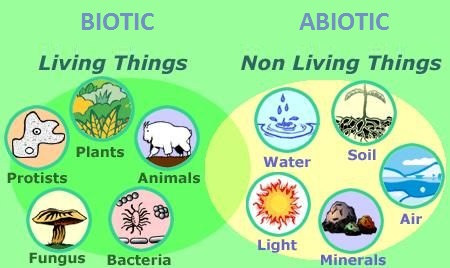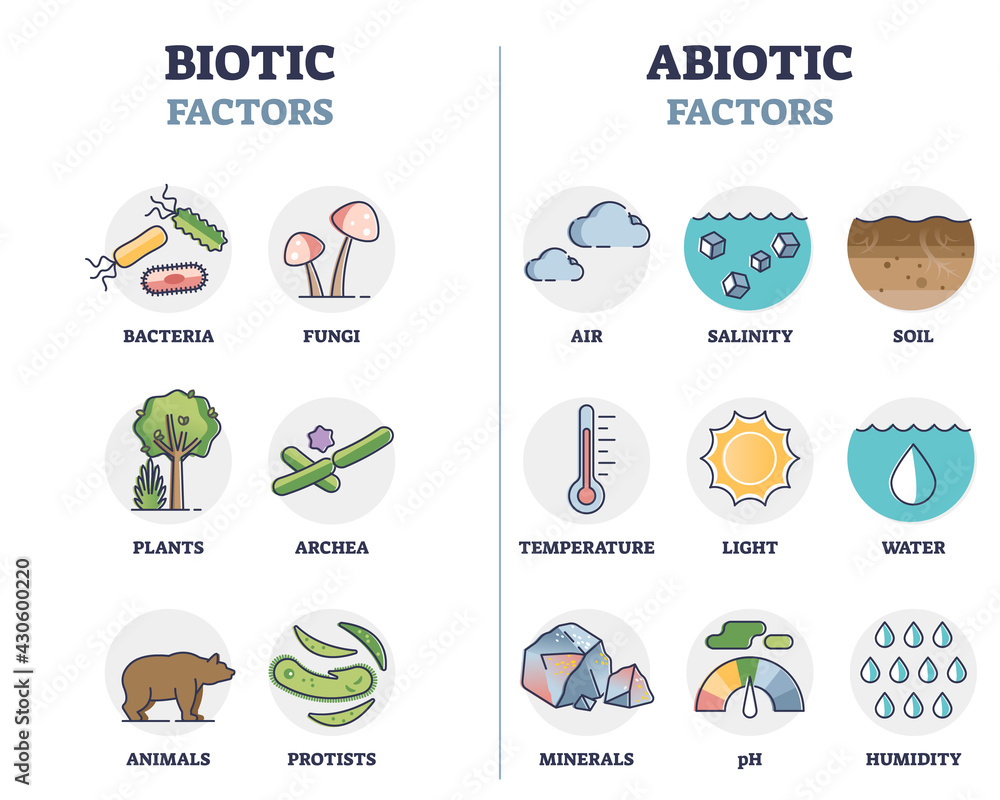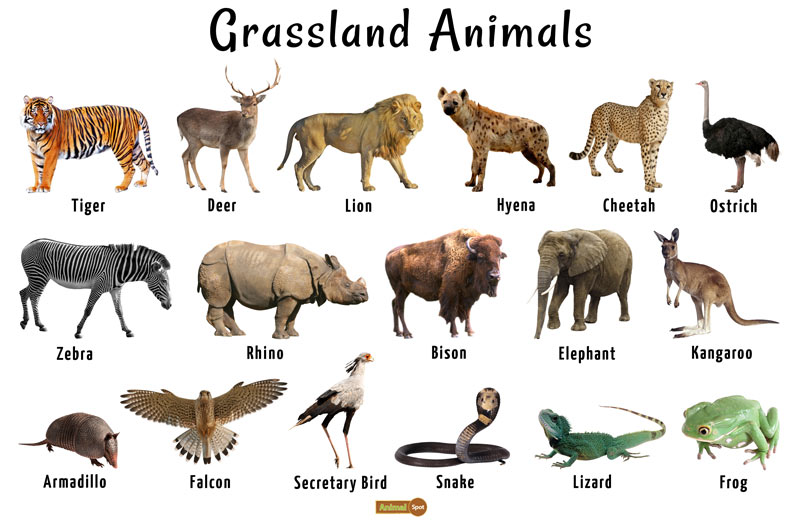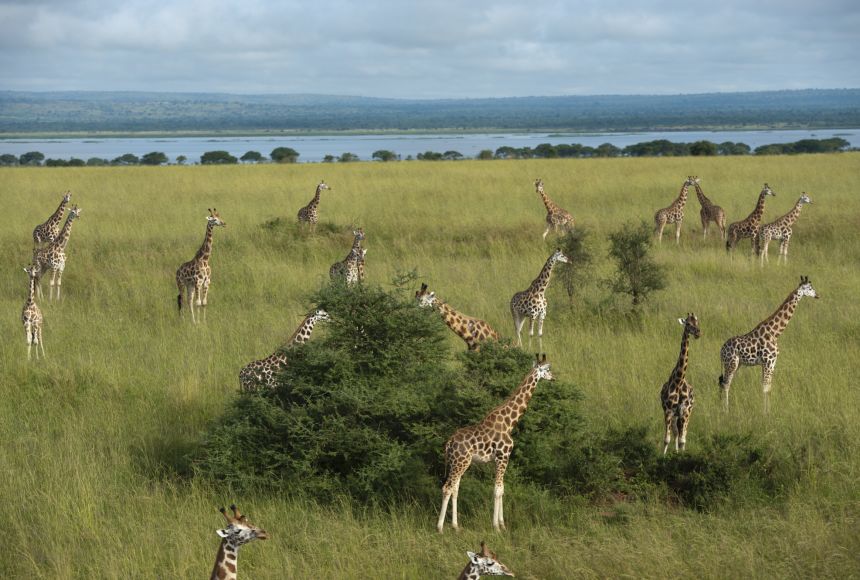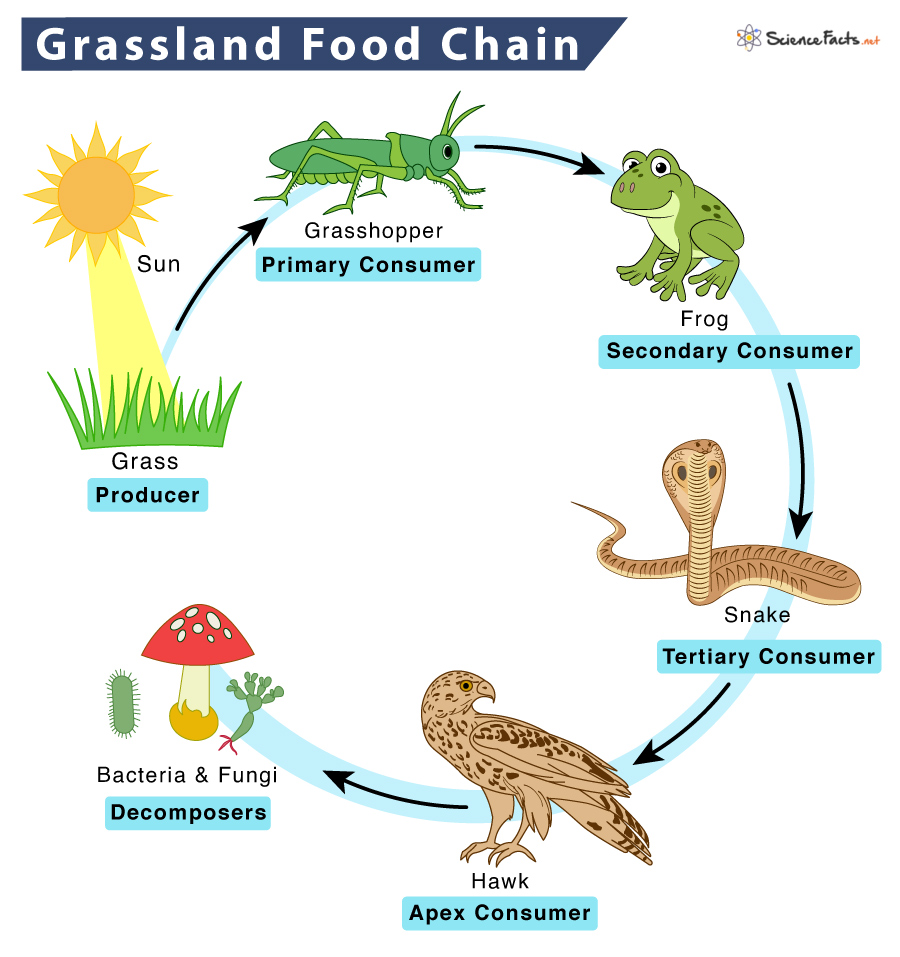Topic what is biotic and abiotic factors in ecosystem: Explore the fascinating world of ecosystems through the lens of biotic and abiotic factors, uncovering the essential roles and dynamic interactions that sustain life on Earth.
Table of Content
- What are biotic and abiotic factors in an ecosystem?
- Understanding Ecosystems: The Role of Biotic and Abiotic Factors
- Key Biotic Factors: Plants, Animals, Microorganisms
- Exploring Abiotic Factors: Water, Soil, Climate
- The Interaction Between Biotic and Abiotic Components
- YOUTUBE: Ecosystems: Biotic and Abiotic Factors
- Examples of Biotic and Abiotic Factors Working Together
- How Abiotic Factors Affect Biotic Elements in Ecosystems
- The Importance of Biotic and Abiotic Factors in Conservation
- Adapting to Abiotic Factors: Strategies of Biotic Elements
- Climate Change: Its Impact on Biotic and Abiotic Factors
What are biotic and abiotic factors in an ecosystem?
In an ecosystem, there are two main types of factors that influence and shape the environment: biotic factors and abiotic factors.
Biotic factors consist of all the living organisms within an ecosystem. These include plants, animals, fungi, bacteria, and other microorganisms. Biotic factors interact with each other and with the abiotic factors in the ecosystem.
Abiotic factors refer to the non-living components of an ecosystem. These factors have a significant impact on the survival and distribution of organisms in the ecosystem. Abiotic factors can include sunlight, temperature, water availability, soil composition, air quality, and other physical and chemical factors.
Biotic and abiotic factors are interconnected and together they determine the structure, composition, and dynamics of an ecosystem. Here is a summary of the key differences between biotic and abiotic factors:
- Biotic factors:
- - Living organisms
- - Examples: plants, animals, bacteria
- - Interactions: predation, competition, symbiosis
- Abiotic factors:
- - Non-living components
- - Examples: sunlight, temperature, water
- - Influence: availability of resources, habitat suitability
Understanding the roles and interactions of biotic and abiotic factors is crucial for comprehending the functioning and balance of ecosystems. By studying these factors, scientists can gain insights into the relationships between organisms and their environment, and how disturbances or changes to the ecosystem can affect its overall health and stability.
READ MORE:
Understanding Ecosystems: The Role of Biotic and Abiotic Factors
An ecosystem is a complex network where living organisms (biotic factors) interact with their physical environment (abiotic factors) to form a self-regulating system. This section explores the fundamental concepts of biotic and abiotic components and their indispensable roles in sustaining ecosystems.
- Biotic Factors: These are the living elements within an ecosystem, including plants, animals, bacteria, fungi, and any other living organisms. They play crucial roles in the flow of energy through the food chain and contribute to the reproductive and growth processes that sustain the ecosystem.
- Abiotic Factors: These are the non-living physical and chemical elements in the ecosystem, such as water, soil, air, temperature, and sunlight. Abiotic factors determine the environment in which the ecosystem"s biotic components thrive, directly influencing their growth, survival, and reproduction.
The interaction between biotic and abiotic factors creates a dynamic system where each component affects and is affected by the others. This balance is crucial for the health and stability of ecosystems. For example, sunlight (an abiotic factor) influences plant growth (biotic factor), which in turn provides food and oxygen for other living organisms within the ecosystem.
Understanding these interactions is essential for conservation efforts, as it allows us to see how changes in abiotic factors, like climate change, can impact the entire ecosystem. Similarly, understanding the role of biotic factors in the ecosystem helps us appreciate the importance of biodiversity and the consequences of species extinction.

Key Biotic Factors: Plants, Animals, Microorganisms
An ecosystem is a complex network where living organisms (biotic factors) interact with their physical environment (abiotic factors) to form a self-regulating system. This section explores the fundamental concepts of biotic and abiotic components and their indispensable roles in sustaining ecosystems.
- Biotic Factors: These are the living elements within an ecosystem, including plants, animals, bacteria, fungi, and any other living organisms. They play crucial roles in the flow of energy through the food chain and contribute to the reproductive and growth processes that sustain the ecosystem.
- Abiotic Factors: These are the non-living physical and chemical elements in the ecosystem, such as water, soil, air, temperature, and sunlight. Abiotic factors determine the environment in which the ecosystem"s biotic components thrive, directly influencing their growth, survival, and reproduction.
The interaction between biotic and abiotic factors creates a dynamic system where each component affects and is affected by the others. This balance is crucial for the health and stability of ecosystems. For example, sunlight (an abiotic factor) influences plant growth (biotic factor), which in turn provides food and oxygen for other living organisms within the ecosystem.
Understanding these interactions is essential for conservation efforts, as it allows us to see how changes in abiotic factors, like climate change, can impact the entire ecosystem. Similarly, understanding the role of biotic factors in the ecosystem helps us appreciate the importance of biodiversity and the consequences of species extinction.
Exploring Abiotic Factors: Water, Soil, Climate
Abiotic factors are the non-living parts of an ecosystem that play a pivotal role in supporting and shaping the living biotic community. Among the most significant abiotic components are water, soil, and climate, each of which has a profound influence on the types of life that can thrive in an environment.
Water
Water is essential for all forms of life, serving as a medium for biochemical reactions, transportation of nutrients, and temperature regulation. The availability, quality, and movement of water within an ecosystem directly affect the distribution and health of plants and animals. Aquatic ecosystems are entirely dependent on water, while terrestrial ecosystems rely on rainfall, groundwater, and rivers.
Soil
Soil quality and composition are critical for plant growth, which in turn supports a wide range of animal life through food chains. Soil types vary greatly from one ecosystem to another, influencing what kinds of plants can grow, how well they thrive, and the types of microorganisms present. Factors such as pH, nutrient content, texture, and depth of soil all play a role in shaping the terrestrial ecosystem.
Climate
Climate encompasses the long-term patterns of temperature, humidity, wind, and precipitation in an area. It determines the types of ecosystems that can exist in different regions, from tropical rainforests to deserts and tundra. Climate affects the seasonal availability of resources, breeding cycles, migration patterns, and ultimately the survival and distribution of species.
The interplay between water, soil, and climate forms the foundation upon which ecosystems are built. These abiotic factors not only determine the physical and chemical environment but also influence biological processes and interactions among living organisms. Understanding the role and dynamics of abiotic factors is crucial for conservation efforts and predicting how ecosystems will respond to changes, such as global warming and human activities.

The Interaction Between Biotic and Abiotic Components
The seamless interaction between biotic (living) and abiotic (non-living) components is what sustains life in any ecosystem. These interactions are complex and multifaceted, influencing the growth, reproduction, and survival of organisms. They also determine the structure and dynamics of the ecosystem itself. Here’s how these components interact:
- Nutrient Cycling: Abiotic factors like soil and water play a crucial role in nutrient cycling, breaking down organic matter from dead biotic components into nutrients that can be reused by living plants and microorganisms. This recycling of nutrients is essential for the productivity of the ecosystem.
- Photosynthesis: Sunlight, an abiotic factor, is fundamental for photosynthesis in plants. This process not only provides food (energy) for plants but also for animals up the food chain. Oxygen, a byproduct of photosynthesis, is crucial for the respiration of most biotic components.
- Habitat Provision: Abiotic elements like rocks, water bodies, and climate conditions create habitats for various biotic organisms, influencing their distribution and behavior. For instance, aquatic ecosystems are shaped by water salinity, temperature, and flow, each supporting different types of life forms.
- Population and Community Dynamics: Climate and weather patterns (abiotic factors) directly affect the reproductive rates, migration patterns, and survival of species (biotic factors). Seasonal variations can trigger breeding seasons, migration, and hibernation in various species, shaping the ecological community.
These interactions are not one-way streets; biotic components can also influence abiotic factors. For example, vegetation can alter soil composition and structure, while animal migrations can affect nutrient distribution. The interdependence of biotic and abiotic components underscores the delicate balance within ecosystems, where changes to one element can have far-reaching impacts on the whole system.
Ecosystems: Biotic and Abiotic Factors
Ecosystems: Biotic and Abiotic Factors - Factors: Discover the intricate web of life in our ecosystems! Uncover the secrets of biotic and abiotic factors, the essential building blocks that shape and sustain these diverse habitats. Join us on a mesmerizing journey as we unravel the fascinating relationship between organisms and their environment, and gain a deeper appreciation for the delicate balance of factors that keep our ecosystems thriving.
Biotic and Abiotic Factors
Biotic and Abiotic Factors - Biotic/Abiotic: Ready to explore the dynamic forces that dictate life on Earth? Delve into the captivating world of biotic and abiotic factors, where living organisms and non-living elements collide to create an extraordinary tapestry of existence. Unveil the astonishing interplay between these vital forces and witness how they shape the destiny of countless organisms. Embark on an awe-inspiring adventure to understand the incredible role of biotic and abiotic factors in our planet\'s remarkable diversity.
Examples of Biotic and Abiotic Factors Working Together
The interconnectedness of biotic and abiotic factors is evident in every ecosystem, creating a complex web of interactions that support life. Here are some vivid examples that illustrate how these factors work together:
- Coral Reefs: In coral reefs, the water"s temperature (abiotic) plays a significant role in the health of coral polyps (biotic). Coral polyps build reefs by secreting calcium carbonate, dependent on sunlight (abiotic) for photosynthesis performed by their symbiotic algae. These reefs then provide habitat and protection for many marine species.
- Forests: In forests, sunlight and soil (abiotic) influence the types of trees and vegetation (biotic) that can grow. Trees, in turn, modify the soil composition through leaf litter and root systems, affecting the moisture and nutrient content available for other plants and microorganisms.
- Deserts: In deserts, water scarcity (abiotic) dictates the species of plants and animals (biotic) that can survive. Cacti and succulents store water in their tissues, while animals like reptiles and rodents have adaptations to conserve water, showcasing a direct adaptation to abiotic factors.
- Wetlands: Wetlands exhibit a dynamic interaction where water levels and quality (abiotic) influence plant types, which in turn provide habitats for a variety of aquatic and terrestrial animals. These ecosystems are crucial for filtering pollutants from water, a service that benefits both the biotic community and the abiotic environment.
These examples highlight the symbiotic relationship between living organisms and their physical surroundings. Through evolution, species have adapted to their abiotic environment, while simultaneously modifying it, showcasing the intricate balance and dependency that characterizes natural ecosystems.
How Abiotic Factors Affect Biotic Elements in Ecosystems
Abiotic factors, the physical and chemical components of an ecosystem, have a profound influence on the life and survival of biotic elements (living organisms). These non-living factors can determine the health, distribution, and behavior of organisms. Here’s an in-depth look at the impact of abiotic factors on biotic elements:
- Temperature: It affects metabolic rates of organisms and dictates the geographic distribution of species. Animals and plants have specific temperature ranges within which they can survive, reproduce, and thrive. Extreme temperatures can limit the presence of certain species to more favorable environments.
- Light: Sunlight is essential for photosynthesis in plants, which is the basis of most food chains. The availability of light can influence plant growth and, by extension, habitats for animals. In aquatic ecosystems, light penetration affects the depth at which photosynthetic life can exist.
- Water: Availability of water influences the survival of all terrestrial life forms. Water scarcity or abundance shapes ecosystems, from arid deserts to lush rainforests, and affects the strategies organisms use for hydration, reproduction, and habitat selection.
- Soil Composition: The type, pH, and nutrient content of soil determine the vegetation that can grow in an area, which in turn supports certain animal communities. Soil quality affects plant health, crop yields, and the microorganisms that live within it.
- Salinity: Salinity levels in water bodies influence the types of aquatic organisms that can live in those environments. From freshwater species to marine life, organisms are adapted to survive in specific salinity ranges.
Abiotic factors also include atmospheric gases, wind, and natural disasters, which can further influence the survival and distribution of organisms. The interplay between abiotic and biotic factors highlights the adaptability and resilience of life in various ecosystems, underscoring the importance of maintaining ecological balance for the survival of all species.
The Importance of Biotic and Abiotic Factors in Conservation
Conservation efforts are crucial for sustaining ecosystems, preserving biodiversity, and ensuring the well-being of future generations. Recognizing the importance of both biotic (living) and abiotic (non-living) factors is fundamental in these efforts. Here’s why each plays a critical role in conservation:
- Maintaining Ecosystem Services: Ecosystems provide essential services such as air and water purification, climate regulation, and pollination of crops. Both biotic and abiotic factors contribute to these services. For example, plants (biotic) release oxygen and absorb carbon dioxide, while water bodies (abiotic) serve as natural filters.
- Supporting Biodiversity: Biodiversity relies on the complex interactions between biotic elements and their abiotic environment. Conservation strategies must account for these interactions to protect endangered species and maintain the genetic diversity necessary for ecosystems to adapt to changes, such as climate change.
- Climate Change Mitigation: Abiotic factors like atmosphere composition affect global climate patterns. Through conservation of forests and oceans, we can influence these abiotic factors, sequestering carbon dioxide (a greenhouse gas) and mitigating the effects of climate change.
- Promoting Sustainable Use: Understanding the limits and functions of abiotic factors, such as soil fertility and water availability, helps in developing sustainable agricultural practices that protect natural resources while ensuring food security.
- Resilience to Natural Disasters: Healthy ecosystems can offer protection against natural disasters. Mangroves and coral reefs (biotic) reduce the impact of storm surges and tsunamis, while mountain forests (biotic) can help prevent landslides by stabilizing the soil (abiotic).
Effective conservation requires a holistic approach that acknowledges the interconnectedness of biotic and abiotic factors. By preserving these elements, we safeguard the resilience of ecosystems against disturbances and ensure their capacity to support life. This approach not only benefits the natural world but also humanity, by preserving the natural resources and environmental conditions upon which we depend.

Adapting to Abiotic Factors: Strategies of Biotic Elements
Biotic elements, such as plants, animals, and microorganisms, employ various strategies to adapt to abiotic factors like temperature, water availability, sunlight, soil conditions, and other non-living elements of their ecosystems. These adaptations are crucial for their survival, growth, and reproduction. Understanding these strategies offers insights into the resilience of life in diverse environments.
Plant Adaptations
- Drought Resistance: Plants in arid regions develop deep root systems to access water, or succulent leaves to store water.
- Temperature Tolerance: Alpine plants have antifreeze proteins to survive freezing temperatures, while desert plants have reflective leaf surfaces to deflect intense sunlight.
- Soil Adaptations: Some plants can grow in nutrient-poor soils by forming symbiotic relationships with nitrogen-fixing bacteria or mycorrhizal fungi, enhancing nutrient uptake.
Animal Adaptations
- Thermoregulation: Animals such as foxes and hares change their fur color and density with seasons to regulate temperature and camouflage. Reptiles bask in the sun to regulate body temperature.
- Migration: Many bird species migrate to warmer climates during winter to access food and optimal breeding sites.
- Behavioral Adaptations: Animals adapt their behavior to conserve water, such as being nocturnal to avoid daytime heat.
Microorganism Adaptations
- Extremophiles: Microorganisms like archaea thrive in extreme conditions, such as hot springs or salt pans, by altering their metabolic pathways.
- Symbiosis: Certain bacteria and fungi form symbiotic relationships with plants, providing them with essential nutrients in exchange for carbohydrates.
Human Impact and Conservation
Human activities, such as deforestation, pollution, and climate change, are altering abiotic factors at an unprecedented rate, challenging the adaptive capabilities of biotic elements. Conservation efforts aim to mitigate these impacts by preserving natural habitats, restoring degraded ecosystems, and promoting sustainable practices that reduce environmental stressors.
Conclusion
Adaptation to abiotic factors is a testament to the resilience of life. By understanding and supporting the complex interplay between biotic and abiotic elements, we can foster healthier ecosystems and a more sustainable coexistence with nature.
READ MORE:
Climate Change: Its Impact on Biotic and Abiotic Factors
Climate change significantly affects both biotic (living) and abiotic (non-living) components of ecosystems, leading to profound changes in their structure, function, and the services they provide. Rising temperatures, altered precipitation patterns, increased levels of carbon dioxide, and more frequent and intense extreme weather events are some of the manifestations of climate change that directly or indirectly influence the dynamics of ecosystems.
Impact on Abiotic Factors
- Temperature Increases: Rising global temperatures can alter the physical properties of ecosystems, affecting everything from weather patterns to ocean currents.
- Changes in Precipitation: Altered rainfall patterns can lead to droughts or flooding, significantly impacting water availability for plants, animals, and humans.
- Sea-Level Rise: The melting of ice caps and glaciers contributes to higher sea levels, affecting coastal ecosystems through erosion, saltwater intrusion, and habitat loss.
Impact on Biotic Factors
- Species Distribution: Warmer temperatures and changing precipitation patterns can shift the geographic range of many species, sometimes pushing them towards higher elevations or latitudes.
- Phenological Shifts: Changes in climate can alter the timing of biological events such as flowering, migration, and breeding, disrupting ecological interactions.
- Increased Pest Outbreaks: Warmer temperatures can enhance the survival and reproduction rates of various pests and pathogens, leading to more frequent outbreaks that can devastate ecosystems.
Adaptation and Mitigation Strategies
Adapting to and mitigating the impacts of climate change on ecosystems involves a combination of strategies aimed at reducing greenhouse gas emissions, protecting and restoring natural habitats, and enhancing the resilience of ecosystems. These include:
- Conservation: Protecting existing natural habitats to preserve biodiversity and ecosystem services.
- Restoration: Rehabilitating degraded ecosystems to improve their functionality and resilience against climate change.
- Sustainable Practices: Implementing sustainable agricultural, forestry, and fisheries practices to reduce environmental impacts and enhance ecosystem health.
Conclusion
Climate change poses a significant threat to both biotic and abiotic elements of ecosystems, but through concerted global efforts in conservation, restoration, and the adoption of sustainable practices, it is possible to mitigate its impacts and safeguard the planet"s biodiversity and ecosystem services for future generations.
